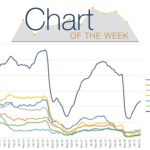Hedging programs that E&Ps have in place in 2016 vary considerably. The chart below shows the range of oil and gas production for several E&Ps covered by hedging contracts.

Pioneer Natural Resources (ticker: PXD) and Cimarex Energy (ticker: XEC) have hedged the largest portions of their remaining production at 85/75 and 80/90 percent, respectively, for oil and gas. This chart does not indicate what percent of production were hedged in that range, although PDC’s averaged to ~$73, with swaps providing further support.
PDC Energy (ticker: PDCE) and Newfield Exploration (ticker: NFX) set their contracts early on, having secured “costless collars” in the $75 to $90 range. In addition to its swaps, PDC is set to secure good prices per barrel of oil. Gas contracts were not covered in this study.
Pioneer, RSP Permian (ticker: RSPP), and Whiting Petroleum (ticker: WLL), the next cohort, have all set up three-way collars through a combination of options. These include a sold call, a purchased put, and a sold put, with the sold call establishing a maximum price (ceiling) for the volumes under contract. The purchased put establishes a minimum price (floor), unless the market price falls below the sold put (sub-floor). If this occurs, the minimum price would be NYMEX plus the difference between the purchased put and the sold put strike price.
Five companies have also entered into swap agreements. Commodity swaps involve the exchange of a floating commodity price, in this case the WTI Crude spot price, for a set price over an agreed-upon period. Under this setup, the two sides in the deal agree to exchange cash flows, which are dependent on the price of an underlying commodity.
Oil & Gas 360® will look at other companies’ hedging strategies in future articles.





